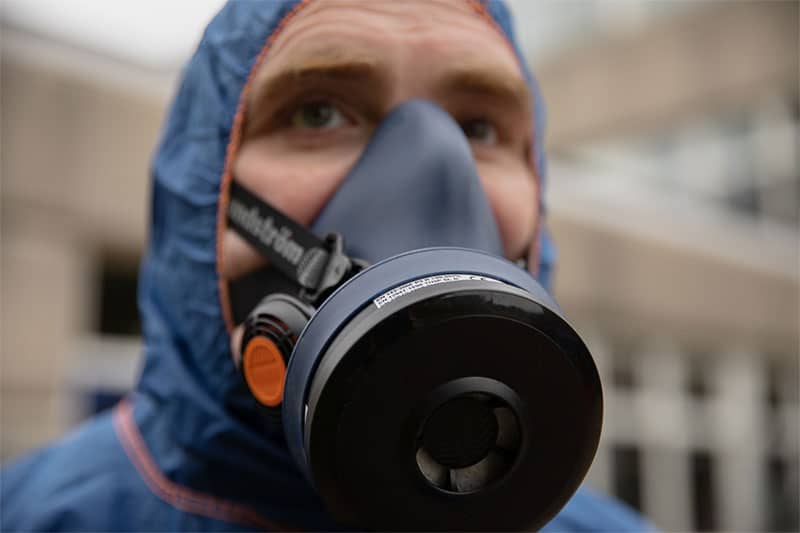What Are the Risks and Hazards Faced by Asbestos Surveyors and Consultants When Carrying Out Their Jobs?
Asbestos surveyors and consultants face a unique set of risks and hazards on the job. Knowing what they’re up against can help you decide if this is the right path for you. If you employ asbestos professionals, it pays to know what they deal with and the best ways to help them.
In this article, we’ll discuss the occupational hazards in the asbestos industry, ranging from physical risks, like asbestos exposure and injury, to mental and emotional needs that must be met.
Physical risks
Physical risks that asbestos surveyors and consultants face range from inhaling dangerous asbestos fibres to having a fall while at a work site.
Asbestos exposure
Asbestos becomes dangerous when it’s damaged or disturbed. Surveyors and consultants have to be in the presence of asbestos in order to do their job. If that asbestos is already damaged or if it becomes damaged while the job is being carried out, anybody in the vicinity is at risk of inhaling asbestos fibres.
When asbestos fibres are inhaled, they stick to the person’s lungs, and they become impossible to remove. This can cause serious health complications as far as decades in the future, including incurable cancers that require aggressive treatments.
Falls and physical injuries
Asbestos-containing materials (ACMs) can be found in different parts of a building, including walls, roofing, and other hard-to-reach areas. Accessing these areas can put surveyors and consultants at risk, especially if they’re not provided with the proper equipment.
According to the Health and Safety Executive (HSE), the Work at Height Regulations 2005 require the following: “Employers and those in control of any work at height activity must make sure work is properly planned, supervised and carried out by competent people.” If this can’t be assured, the job should be put on pause until safe access is secured.
Environmental hazards
Environmental hazards that asbestos surveyors and consultants have to prepare for include the release of asbestos fibres and airborne contamination, which can pose serious health risks to anybody in the area.
Asbestos fibre release
Surveyors have to be careful to not disturb ACMs while surveying a property. Even minor damage to an ACM can lead to fibre release. This puts the surveyor at risk and also contaminates the air as fibres float around.
Since asbestos fibres are microscopic, it can be difficult to know if they’re in the air at all and where they’re present. This makes it difficult to clean up floating asbestos fibres.
Airborne contamination
Once the air is contaminated with airborne asbestos fibres, it’s necessary to monitor and control asbestos levels until a removal project is finished. As we discuss in the article about how long asbestos stays airborne, air monitoring, sampling, and testing are necessary to find out how much asbestos is in the air. This has to be repeatedly done until the asbestos is gone.
During asbestos projects, including inspections and removals, HEPA filter-equipped ventilation systems are often used to keep the air safe for workers. Personal protective equipment (PPE), such as respiratory protective equipment (RPE) and disposable clothing, should always be worn when working with ACMs.
Psychological and emotional challenges
Working with asbestos is a serious job with high stakes. Handling the stress of the job and its emotional burden can be taxing. On top of that, asbestos surveyors and consultants need to have strong communication and conflict-resolution skills.
Stress and emotional burden
It can be difficult to find ACMs in a building, let alone identify them and assess whether or not they’re damaged. Since this is such an important job so that others can stay safe and healthy, there’s a lot of pressure to get it right. Missing even one ACM can mean risking someone’s life. Since a lot of experience is learned on the job, the stress may be even greater for a newer asbestos worker who’s unsure of their level of knowledge.
Additionally, it’s emotionally taxing to regularly work in dangerous environments. Asbestos professionals know that, most days, they’re heading into a space that could pose a great risk to their health. This can feel like an emotional weight to carry every day.
Communication and conflict resolution
Asbestos surveyors and consultants have to work with a property’s duty holder to assess the building. Additionally, depending on the work to be carried out, sometimes a building’s activities have to be shut down temporarily for safety reasons. Unfortunately, it’s common for asbestos professionals to be met with resistance. Some people don’t understand the risks of being around ACMs, figuring that if they’ve been fine so far, there’s no need for changes.
Asbestos professionals also have to make a lot of high-level decisions when it comes to managing ACMs on a site. They have a responsibility to make the best decisions possible for the situation while staying within the law. At the same time, they have to address questions and conflicts that arise, whether that’s from the duty holder, a person who works in the building, or another contracted team that has a project to complete.
Safety measures and best practices
The safety measures and best practices that asbestos professionals have to follow range from the basics, like wearing the right equipment, to long-term planning. Knowing what to do and how to stay safe requires training and practice.
Personal protective equipment (PPE)
HSE has a thorough guide to the PPE needed for asbestos jobs, which states, “PPE and RPE are your last lines of defence against asbestos fibres.” Detailed information about the type of clothing, footwear, and RPE is included in the PDF. The guide also discusses emergency procedures in case PPE fails, training for RPE use, maintenance for equipment, and more.
Training and education
Asbestos surveyors need to receive the proper certification in order to legally practise. Either the Royal Society for Public Health (RSPH) Level 3 Award in Asbestos Surveying or the P402 Surveying and Sampling Strategies for Asbestos in Buildings qualification from the British Occupational Hygiene Society must be achieved.
During this training, students learn about asbestos types, hazards, regulations, and best practices to maintain safety, among other topics. However, a lot of knowledge will be gained on the job. Certification allows the person to work in the industry, but they won’t have expert-level knowledge after completing it.
Following the prerequisites, it’s important for asbestos surveyors and consultants to engage in ongoing professional development so they stay updated on the industry’s best practices. On-the-job experience, refresher trainings, and UKATA approved courses are recommended.
Risk assessment and planning
Before entering a work site, an asbestos surveyor or consultant should conduct as thorough a risk assessment as possible. This may involve researching the type of building they’re inspecting to determine the most likely locations of asbestos and the type of asbestos commonly used. It could also involve analysing the asbestos register, which should include information about where ACMs are located in the building and their condition.
Once the asbestos professional has had a chance to properly assess the property, they will draw up a comprehensive plan that will mitigate the risks and hazards of the project.
Collaborative efforts and support systems
In order to carry out their jobs in a way that protects their health and well-being as well as the safety of those around them, asbestos professionals lean on team efforts and support systems.
Teamwork and communication
Asbestos professionals assigned to a project or site need to communicate well with one another. Whether they’re on the same team or working separately toward the same goal, effective communication is necessary.
Moreover, it’s helpful for all asbestos professionals to share their knowledge and expertise with one another. This gives everyone more context for the job and protects everyone’s safety as much as possible. Also, when it’s clear what everyone’s role is, the project can be handled more efficiently.
Mental health support
As discussed above, working with asbestos can have an emotional and psychological impact. It’s helpful for asbestos workers to have support resources on hand when they need help coping with the job’s stressors. Overall, there should be a culture of well-being promoted within the industry so that professionals know they’re not alone and that their health is a top priority.
Conclusion
It’s well-known that working with or around asbestos can be a dangerous and life-threatening job. The true hazards that asbestos professionals face are even more complex than that. They include:
- Physical risks such as exposure and injury
- Environmental hazards when asbestos fibres become airborne
- Psychological and emotional challenges, including stress and the need to solve conflicts
- Safety measures and best practices, from wearing the right equipment to project planning
- Ensuring there’s a support team at the ready to help with job-related issues
These types of high-risk jobs demand that training, safety measures, and support are handled professionally. Everyone in the asbestos industry will benefit from a collective commitment to protecting the health and well-being of one another.

Written by Brendan Coleman
Brendan Coleman, with decades of experience in the asbestos industry, is a dedicated Quality Manager. Certified as a surveyor and analyst, he is adept in operations and quality management with a keen focus on HSE compliance. His expertise is pivotal in maintaining high safety and efficiency standards. Brendan ensures our UKAS accreditation requirements are consistently met and exceeded, upholding stringent standards in asbestos remediation. His commitment to enhancing quality and customer satisfaction makes him an essential advisor in asbestos management.

